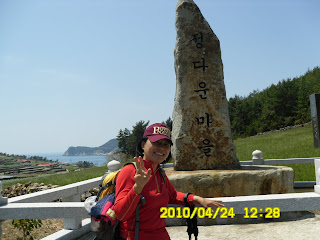No. 264th AhToSan Regular Hike (My 198th hike with AhToSan) was CheongSanDo (Blue Mountain Island) in WanDo, JeonNam Province.
It was originally 3 peak-12 kilometer hike (6 hours), but only 10 fast-hikers achieved the complete course, the rest of us (14 including myself) completed only 2 peaks, and alternated to the easier course, skipping the last peak called “BoJeokSan.”
Wando is located in the south western part of Korea Peninsula. It is in the middle of Dadohae Maritime National Park. (“Dadohae” means a lot of islands. ChongSanDo is one of them.)

[Ferry Terminal of Wando、莞島(ワンド)のフェリー・ターミナル、완도 페리 여객 터미널]
This time, one of my Korean-studying Japanese friends, Mr. M joined us. Beside us, my Mexican friend, B and my English speaking Korean friend, H, joined this hiking trip.

[In front of a small park near Wando Port, 莞島港のそばの小公園にて、 완도항 옆 소 공원에서]
We left Expo South Gate of Daejeon at 1 a.m. and arrived at the port in Wando at 5:30 a.m. While the leader of this hike was on the line to buy ferry-boat tickets, rest of us cooked instant rahmen, and ate breakfast at a small park in front of Wando Port.

[Breakfast at a small park near the port of Wando, 莞島の港のそばの小公園で朝食、완도 항구 옆 소 공원에서 아침 식사]
Boarding began at 6:40 and the ferry left the port at 7 a.m. We arrived at DoCheong Port of ChongSanDo at 7:50, and began hiking at 8 a.m.
The hiking was smooth at the beginning, but we were soon trapped in the bush with a lot of stones and rocks under the weeds and vines. We struggled for more than 30 minutes to find proper trails. The hiking became much easier after we came out to the trail along the ridge.

[Beginning of the hike、ハイキング開始、하이킹 시작]

[Difficult part of the hike、「野石地帯」で苦労、"노돌 지대"에서 고생했다]
The trail was really nice with a lot of flowers along it. We enjoyed taking pictures of beautiful scenes, as well as plants and insects, etc.

[Pasque flower、オキナグサの花、할미꽃]

[Azalea flowers, ツツジの花、철쭉 꽃]

["iris" like flower、アヤメのような花、붓꽃과 같은 꽃]
The distance between the fast-hikers and non-fast-hikers became big. When we (slow hikers) arrived at the foot of the final peak of BoJeokSan, the fast-hikers were already in the middle of the mountain. We, slow-hikers gave up the final peak, and decided to have lunch there.

[Lunch time、昼食、점심]
We enjoyed the beauty of scenes, and sight-seeing at the famous movie (Seopyeongje) and TV drama (Spring Waltz) locations.

[Board shows the location of "Seopyeongje"、「風の丘を越えて」撮影地を示す看板、「서편제」 촬영지을 나타내는 간판]
Seopyeongje:http://en.wikipedia.org/wiki/Seopyeonje
Spring Waltz:http://en.wikipedia.org/wiki/Spring_Waltz

[House of Spring Waltz, 春のワルツの家、봄의 왈츠 집]
I walked with B and H, but Mr. H joined the fast-hiker group. Later he said it was a bit hard hike for him. He got so tired that he was cramped his legs on the board returning to Wando.

[In the rape blossoms, 菜の花畑にて、유채꽃밭에서]
However, Mr. M got off at Wando and he went traveling around Wando-Dadohae National Maritime Park by himself.
Rest of us enjoyed “Tippuri” at a small park in Wando. We ate “pig legs” and “Wolf-berry” wine.
Wolf-berry:
http://en.wikipedia.org/wiki/Wolfberry
2010年4月24(土)快晴
アトサン定期登山264回(私は198回目)の登山は全南・莞島(ワンド)の青山島(チョンサンド청산도)という島で、島の3分の1ほどのコース12キロメートルを約6時間であるいた。
莞島は韓半島の南西部、全羅南道の多島海海上国立公園の中にある大きな島(莞島郡の人口は約6万人弱)で、半島とは橋で連結されている。

[A map of Wando, 莞島の地図,완도 지도]
今回は日本の友人M氏がソウルからやってきて大田で合流。ほかにベストメンバーのメキシコ人B、日本語ができるイタリアレストランのオーナーHも参加し、アトサン全体では参加者23人。

[At the pier of CheongSanDo, 青山島の桟橋にて、청산도 부두에서]
大田を深夜1時に出発し、莞島の港には5時半に到着。代表者が窓口に並んで乗船券を購入している間に、港前の公園でラーメンを煮て、弁当の朝食を食べた。
6時40分にフェリー乗船し、7時に出港。青山島のトチョン港(도청항)には8時前に到着した。

[On the ferry, フェリーの中で、페리 안에서]
この日のために事前に島を訪れたチョンジョン総務の説明を受けて、登山開始。トチョン港を眼下に見ながら丘を登ったが、山道に入ってすぐ登山路がわからなくなり、足場の悪い岩の上に蔓が生い茂ったノドル地帯でしばらく悪戦苦闘した。

[The leader explains the course, 登山コースを説明するチョンジョン総務、등산 코스를 설명하는 정정 총무]

[The first "rest" with fruit, 最初の休憩、처음 휴식]
1時間ほどで稜線に出てからは比較的ゆるやかな登山路をテソン山(대선산)、コソン山(고성산)と進んだ。

[Mark stone of DaeSeonSan, テソン山の石標、대선산 돌표]
登山路には非常に丈の低いツツジをはじめとする綺麗な花々が咲き、すばらしかったが、先頭グループと残りのグループの間が開いてしまった。

[Azalea flowers, 岩場に咲くツツジの花、암석 지대에 피는 철쭉 꽃]

我々が今回の最終峰である宝積山(ポジョクサン:보적산)の麓に到着した時は11時過ぎであったが、先頭グループはすでに宝積山登山に挑戦中、我々は腹が空いたのでここで昼食にしようということになり、その差は確定してしまった。
今回の登山時間は6時間で、全員午後2時20分発のフェリーで莞島に戻ることになっているため、先頭グループの10人を除いた14人は宝積山登山を諦め、菜の花畑のなかを、映画「風の丘を越えて」はTVドラマ「春のワルツ」が撮影されたロケ地を回って港へ行くことにした。

[Board shows the location of "Seopyeongje"、「風の丘を越えて」撮影地を示す看板、「서편제」 촬영지을 나타내는 간판]
M氏は先頭グループに入ったため、後で聞いたらかなりきついハイキングだったそうで、最後は走るなど、余裕がなかったそうだ。

[In the rape blossoms with B&H, 友人のBおよびHと菜の花畑にて、친구인B 및 H와 함께 유채꽃밭에서]
私はBやHと共に菜の花の中で写真を撮ったり、花や虫などの自然を楽しんで歩いた。

[One of my good friends, Jeongdaun, posed in front of "Jeongdaun Villege", 友人のチョンダウンが「チョンダウンの村」と書かれた石碑の前でポーズ、친구인 정다운이 「정다운 마을」석비 앞에서 포즈]

[Villeger's house,村人の家、마을의 집]

["Viviparidae" or "river snail"、タニシ、우렁이]

[A ladybug on the palm of B、友人Bの手のひらに止まったテントウムシ、친구B의 손바닥에 앉은 무당벌레]
M氏は帰りのフェリーでは足が攣ったというほど疲れたようだが、莞島で下車、全羅南道を旅してソウルへもどるという。
我々は莞島の中の小さな公園でトンソク(豚足)とクコ酒のティップリを楽しみ、帰路についた。

[After the hike party at a small park in Wando, 莞島の小公園でティップリ、완도의 소 공원에서 뒷풀이]
クコ:http://ja.wikipedia.org/wiki/%E3%82%AF%E3%82%B3
[산행안내]
다도해 최남단 해역의 청산도는 5개의 유인도와 9개의 무인도로 이루어지고 주도인 청산도는 남쪽에 최고봉인 매봉산[385m]과 보적산(321m),북쪽에 대봉산(334m)이 솟아 있고 평지는 읍리와 양중리 부근에 발달하였다. 남쪽해안에는 10∼20m의 높은 해식애가 발달하였고, 동백나무•후박나무•곰솔 등의 난대림이 무성하여 다른 섬들과 함께 다도해해상국립공원의 일부로 지정되어 있다.
청산도는 영화 <서편제>, 드라마 <봄의 왈츠>와 <해신> 등의 촬영지로 이미 아름다운 풍경이 잘 알려져 있다. 그 섬에서는 시간이 더디고, 또 부드럽게 흘러 전남 신안의 증도, 담양의 장평면, 장흥의 유치면과 함께 ‘슬로시티’ 인증을 받았으며 그에 걸맛게 다랑논과 구들장논, 돌담, 해녀, 초분 등의 전통문화를 고스란히 간직하고 있다
느린 곳을 찾을 때는 보는 것도 느끼는 것도 느려야 하는 것이거늘….
무엇보다 청산도에 가면 자연에 순응하며 살아온 사람들의 소박하고 유순한 심성에 놀라게 된다. 그리고 그 사실을 느끼는 순간 계산적으로 살아온 자신이 부끄러워진다. 먼저 조금만 마음의 문을 열고 다가서면 더 활짝 마음을 열고 반갑게 맞아주는 사람들이다.
[登山案内:上記ハングルの翻訳]
多島海(タドヘ)最南端海域の青山島(チョンサンド)は5つの有人島と9つの無人島で構成され、なかでも最大の青山島(チョンサンド)は南側に最高峰の毎峰山(メボンサン)[385m]と宝積山(321m)、北側に大峰(テボン)山(334m)が聳えていて、平地は邑里(ウムニ)とヤンジュン里付近に発達した。 南側海岸には10~20mの高い海蝕崖が発達、椿・ほおの木・黒松などのナンデ林が生い茂って他の島々と共に多島海(タドヘ)海上国立公園の一部と指定されている。
青山島(チョンサンド)は映画<西便制(ソピョンジェ)>,ドラマ<春のワルツ>や<海神>などの撮影地としてすでに美しい風景がよく知られている。この島では時間がゆっくりとまた滑らかに流れて全南(チョンナム)新安のチュンド、潭陽(タミャン)の長坪面(チャンピョンミョン)、長興(チャンフン)の有治面(ユチミョン)と共に「スローシティ」の認証を受けていて、それにあわせて棚田と「クドゥルチャンノン」、石垣、海女、草墳などの伝統文化をそっくり大事に保管している。
ゆっくりとしたところを訪問する時は見るのも感じるのもゆっくりしなければならない….
何より青山島(チョンサンド)に行けば自然に順応して生きてきた人々の素朴で柔順な性格に驚くことになる。 そしてその事実を感じる瞬間、いつも計算的に生きてきた自身が恥ずかしくなる。 先ず少しだけ心の扉を開いて近寄ればさらにパッと心を開いてうれしく迎える人々だ。






















